Yesterday’s live coverage of the Ukraine conflict can be found here. An archive of our liveblogs can be found here. For an overview and analysis of this developing story see our latest podcast.
Please help The Interpreter to continue providing this valuable information service by making a donation towards our costs.
For links to individual updates click on the timestamps.
For the latest summary of evidence surrounding the shooting down of flight MH17 see our separate article: Evidence Review: Who Shot Down MH17?
A disturbing report from Nadia Savchenko’s lawyers, who indicate that she is in danger of starving to death. Censor.net reports:
“I had been in two wars, and I am ready to die in the name of justice. Your Prime Minister Medvedev said that if they cut off the SWIFT system, Russia is ready for all sorts of measures. I am also ready for all sorts of measures. I am holding by the will power. I will go to the end,” she said.
Savchenko acknowledged that the hunger strike has no effect on the Russian authorities and is not yet effective. “Irresistible force met the immovable object,” she said.
Savchenko stated that she intends to write a letter to the chief physician of the jail that she will consider possible force-feeding a torture.
The U.S. State Department is echoing these statements. RFE/RL reports:
U.S. State Department spokesman Jen Psaki says the life of Ukrainian air force officer Nadia Savchenko “hangs in the balance” after 54 days on a hunger strike in a Russian prison.
Psaki called Savchenko “a hostage to Russian authorities” and said Washington demanded her immediate release in accordance with the commitments Russia made under an agreement signed in Minsk in September.
Savchenko, a Ukrainian fighter pilot serving with the Aidar battalion, was captured by Russian-backed fighters, kidnapped across the border into Russia, and is facing murder charges concerning the death of two Russian state journalists in Ukraine whom Savchenko almost certainly never met.
— James Miller
Ukraine’s Information Resistance claims that Ukrainian forces destroyed a unit of Russian or separatist manned Russian tanks outside Debaltsevo over the last few days.
According to the report, a consolidated tank unit of 16 tanks, transferred to the Debaltsevo area from Krasny Luch, was routed during a three-day battle.
7 tanks were, Information Resistance claims, knocked out in the first day of the offensive, and another 4 were destroyed by Ukrainian artillery strikes over the next two days. Three tanks were abandoned for unknown reasons, leaving only two operating. Attempts are being made to recover three of the knocked-out tanks for repair.
Information Resistance posted the following photos from the battlefield. We have not geolocated these images but we do note that they don’t produce prior returns in Google Image search.






The vehicles seen are T-72 tanks (which are not in current service with the Ukrainian army) and a BMP-2 infantry fighting vehicle.
The T-72s in the second and last photos bear the “Н2200” marking, indicating recent transport by rail (the marking indicates a non-standard load, wider or heavier than normal).
Such markings have been seen on both tanks loaded on trains inside Russia and on many tanks and military vehicles operating in separatist-held territory in Ukraine.
— Pierre Vaux
On January 27 a series of rockets hit multiple residential areas in Lugansk. One person was killed by shrapnel and another died from related heart failure. The OSCE has released a report which warns that cluster munitions may have been used in the incident:
The SMM saw considerable damage caused by the impacts of rocket shelling, such as broken windows, fences, gates and walls. The SMM assessed that some of the damage to the buildings, e.g. a series of parallel rows of strike marks on a gate and wall, were consistent with damage typically caused by shrapnel elements from cluster munition. According to the SMM’s assessment, a hole in a roof of a house was caused by the impact of what appears to be a bomblet, with small calibre.
The SMM discovered parts of rockets, including engines, fins and cargo compartments, in the front and backyards of several houses; the cargo compartment in particular is typical of a rocket carrying cluster munitions. Some parts sighted by the SMM at the impact site (1.5 cm white metal fragments, 6 by 3 cm black metal fragments of bomblets cases) are typical for cluster munition. The SMM identified them as parts consistent with 9M55K model “Smerch” rockets (calibre 300mm). The SMM observed a crater (diameter approximately 4m, depth approximately 3m) at the backyard of the house located at Dekabristiv Street 106 which had been caused by the explosion of a “Smerch” rocket, according to the SMM’s assessment.
The SMM measured by compass the angle between north and the axis of cargo remains. The SMM measured the incoming azimuth for the three cargo remains of the “Smerch” rockets, indicating a general incoming north-north-west direction.
If Smerch rockets — with a range of between 20 and 90 kilometers, depending on the variant — came from the north-north west, then they must have been shot from territory controlled by the Ukrainian military.
However, Lugansk News Today, which also has reporters on the ground, took their own measurements of the rockets, and they say that the rockets were launched by “pro-Russian terrorists.”
Yesterday on January 27 2015 at about 6pm Pro-Russian terrorists made an attack on Lugansk. It is not clear if they did it on purpose or they missed and hit residential area. Few rockets were launched from multiple rocket launcher system (MRLS). The launch site is located at the place which is used as a base by pro-Russian terrorists and Russian Army units. Our witness saw the moment of the launch. And right after that people started to report about explosions in another part of Lugansk. We got the video of one of the places that got hit with MRLS that proves the direction where the attack was made from. The distance between the launch site and the area that got his is about 10 km. So far we got visual confirmation of 3 locations that got damaged.
The report, which includes many pictures, is interesting on several points, and it is at odds with some of OSCE’s statements. We assessed their claims ourselves.
Lugansk News Today provides pictures of damage to a train station, which only occurred on the east side, which they say suggests that the rockets came from the southeast. However, the visible damage appears to have been caused by shrapnel, which does not rule out the theory that the rockets came from the north-north west.
In another example, Lugansk News Today takes pictures of what they say is an Uragan rocket (with a range of 35 kilometers). However, as we’ve analyzed below, that rocket does indeed appear to have come from the north-north east:
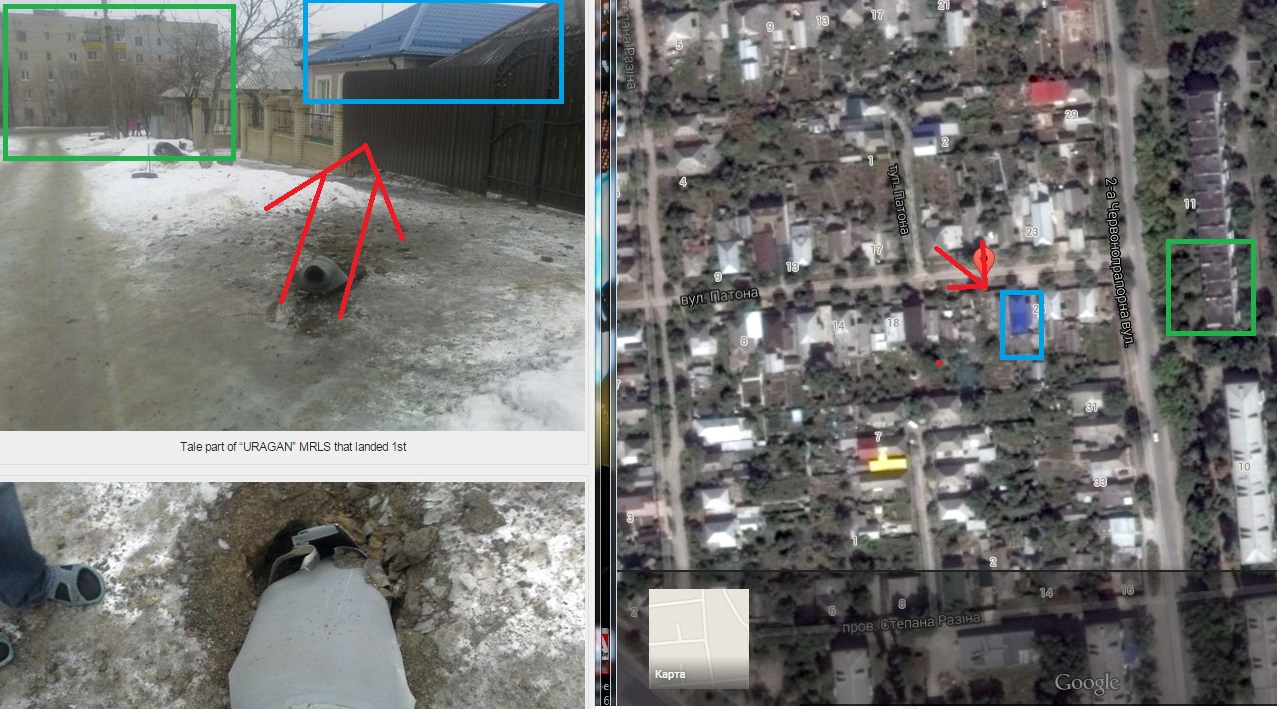
As we see by comparing Google maps to LiveUAMap.com, which is mapping this conflict, that would mean that the rocket came from Ukrainian-controlled territory:
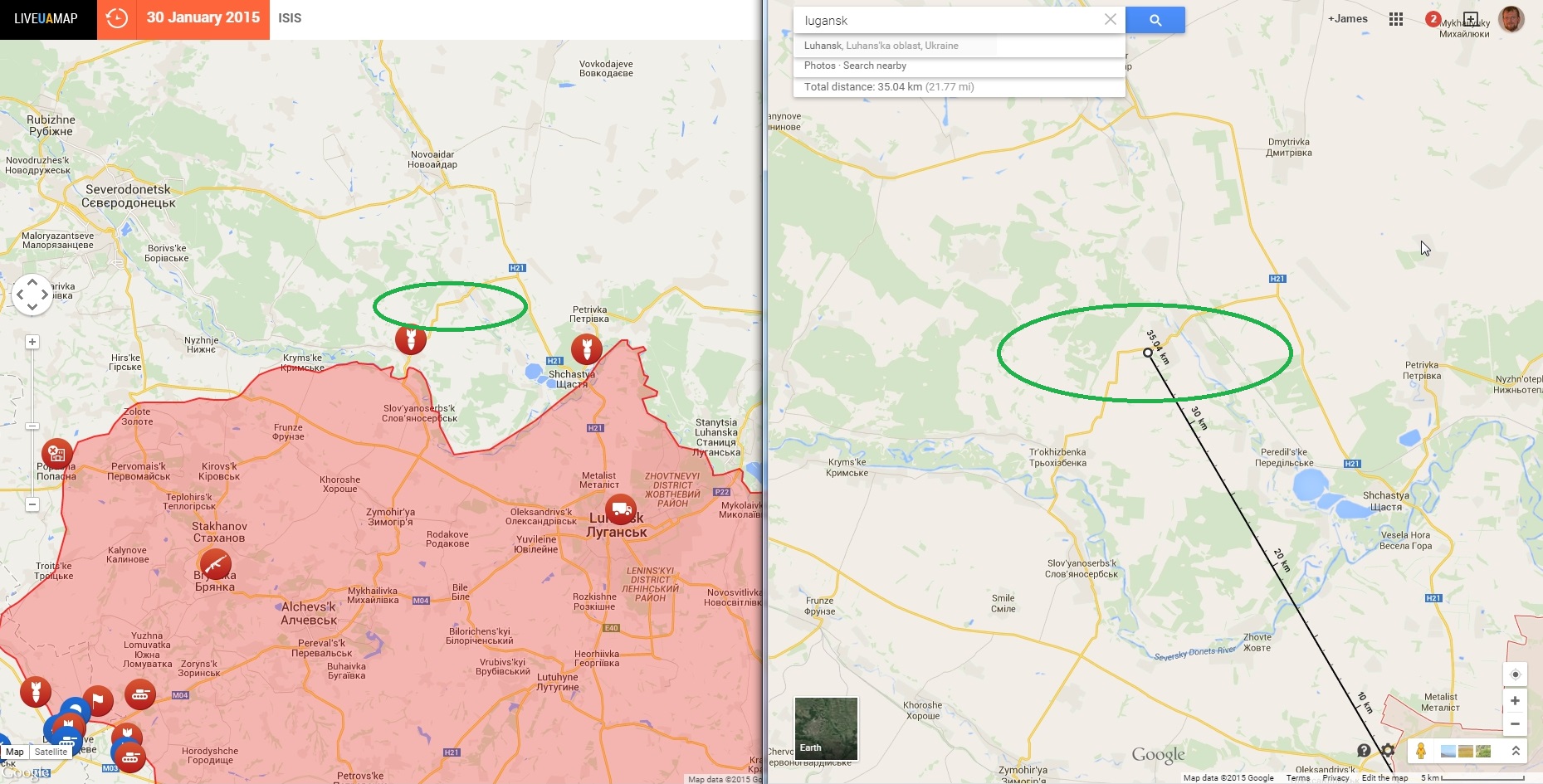
However, Lugansk News Today did post several very interesting pictures, with substantial analysis, which suggests that the building on Izvestkovaya Street may have been hit by weapons that did come from the southeast:


The OSCE SMM mentions this house in its report and says that the damage that hit the roof was caused by falling submunitions.
We cannot definitively say from which direction the munition that did the visible damage to this roof originated.
On February 3 The Interpreter analyzed claims that the Ukrainian government fired an OTR-21 Tochka (SS-21 ‘Scarab’/9M79) ballistic missile near Alchevsk. The Interpreter was unable to confirm the claim that the rocket fell near civilian homes, or even that it was a Ukrainian rocket which may or may not have contained submunitions.
— James Miller
Footage uploaded to YouTube yesterday (February 3), and disseminated on pro-separatist channels, purportedly shows tanks advancing through a destroyed Ukrainian checkpoint at the village of Chernukhino, just outside Debaltsevo.
The footage contains extremely graphic images of dead soldiers, apparently Ukrainian.
Dajey Petros of Ukraine@War calculated the route taken by the tanks as follows:
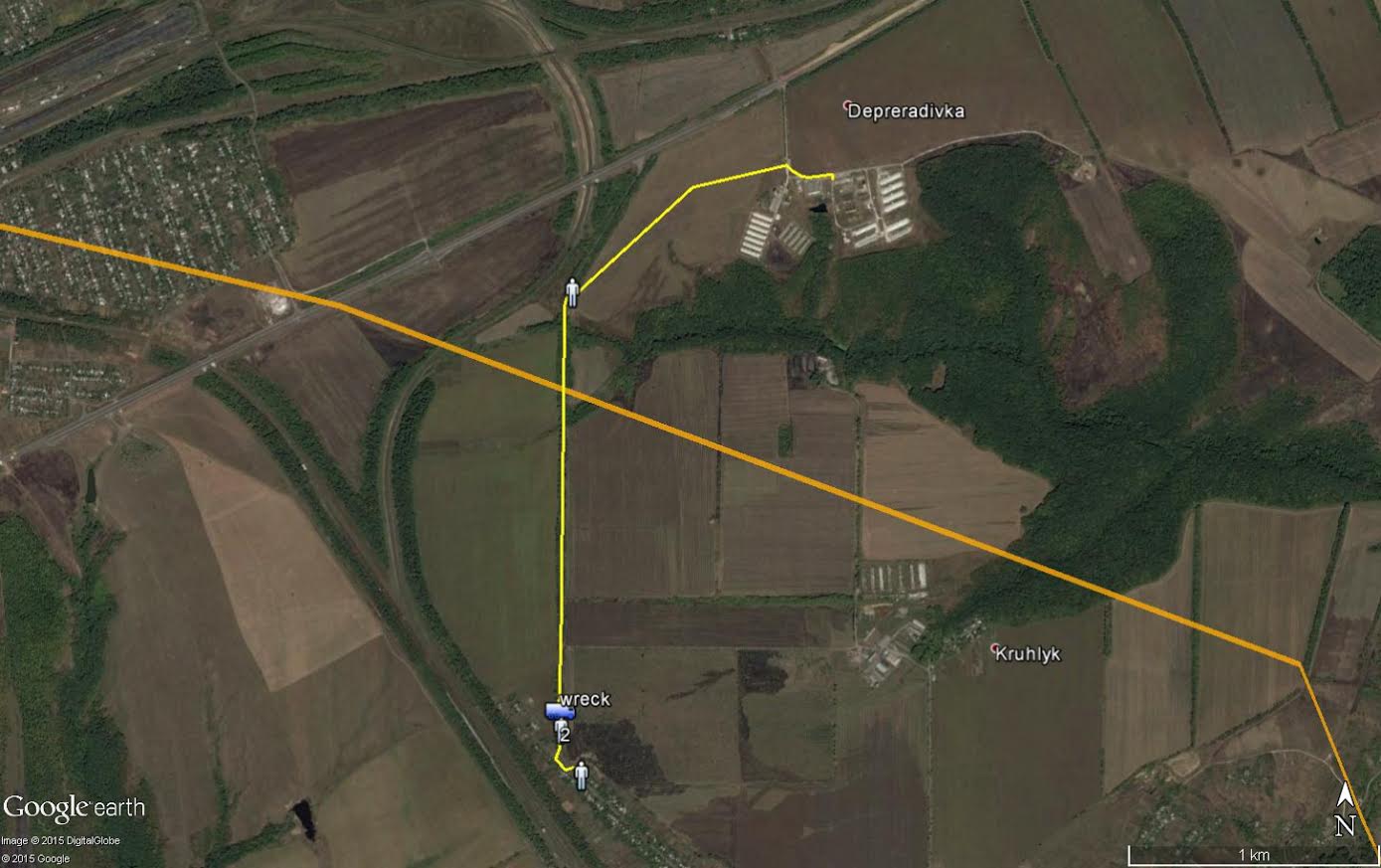
We have verified this geolocation by comparing satellite images of the location indicated here as the start of the route, a chicken farm, with the video footage.
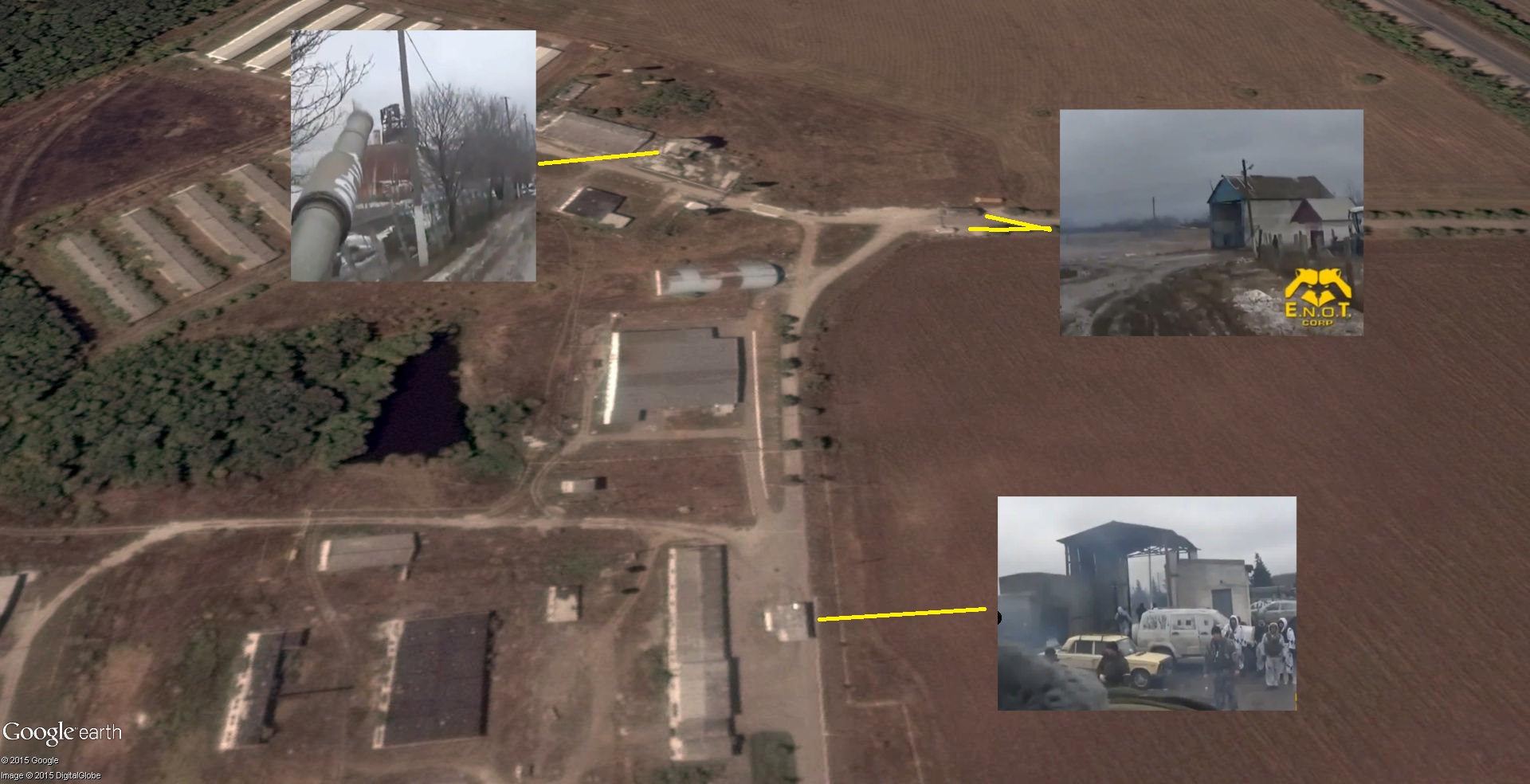
When this route is looked at on a wider scale, the significance of this manoeuvre is made clear:
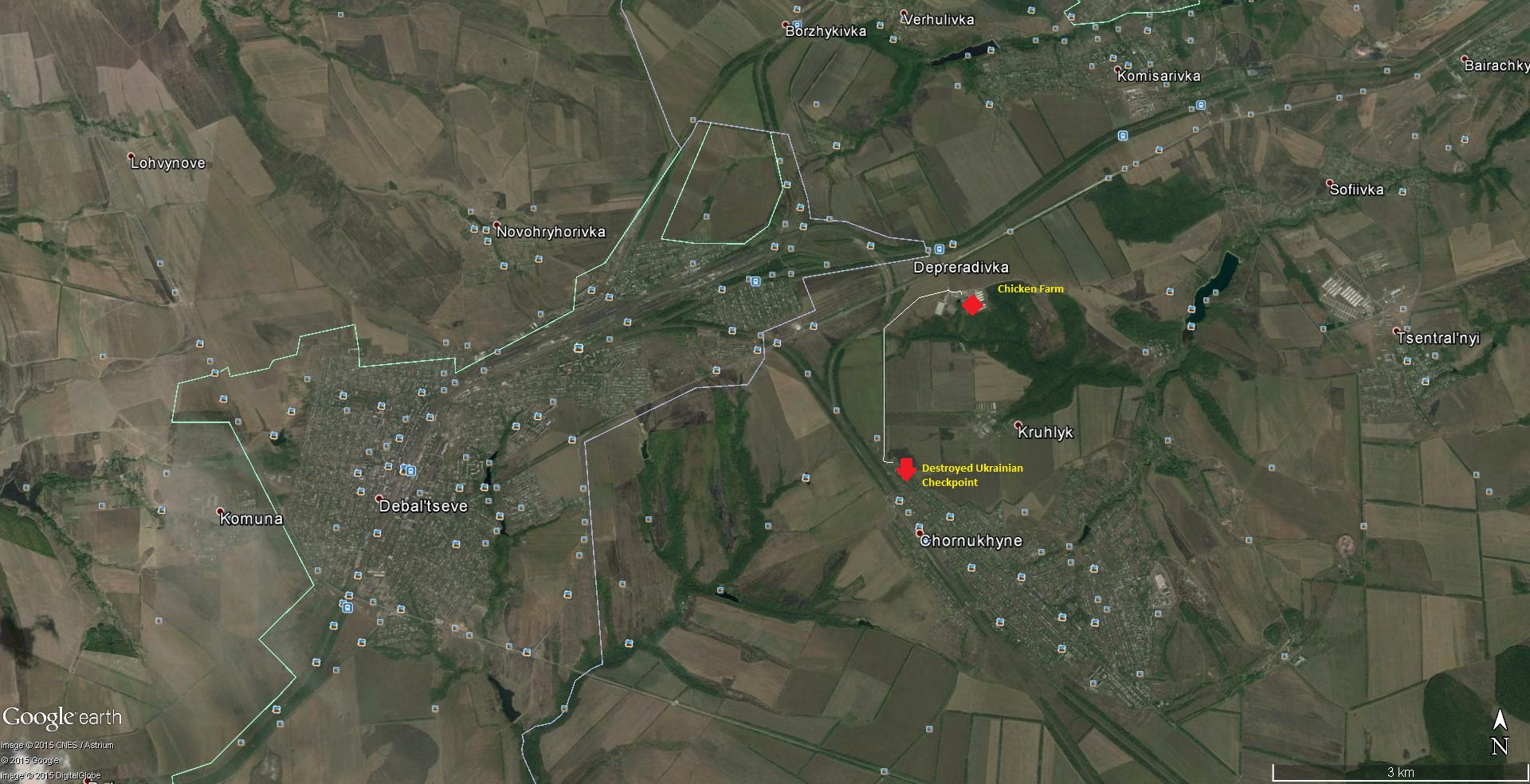
This suggests that, even if territory was not held following this assault in the north of Chenukhino (labelled here with the Ukrainian, Chornukhyne), then Russian or separatist fighters are certainly operating much closer to Debaltsevo itself than we had thought.
They also appear to be able to move between Ukrainian-held settlements, flanking the front line.
This reflects what journalist David Patrikarakos told us on January 29, when he described the front line as “porous.”
The front line is highly fluid — Patrkiarakos described it as “porous,” which heightens the danger of many of the roads. While this situation is dangerous for journalists and, obviously, the combatants, it’s also dangerous for any remaining civilians who are either desperately trying to get away from the fighting, or are now stuck in a war zone.
“That’s the weirdest thing being out there… there isn’t a front in the traditional sense.”
— Pierre Vaux
The pro-separatist Donetsk News Agency (DAN) reports, citing the “chief doctor at the Republic’s Trauma Centre,” that the death toll from this morning’s shelling at hospital number 27 in the Tekstilshchik area of Donetsk has reached five.
Five civilians are reported wounded, amongst them a four-year-old boy, a 21-22-year-old woman with an eye injury and a 24-year-old man with shrapnel wounds and an fractured forearm. These casualties are being treated at the Trauma Centre.
DAN reports that Eduard Basurin, deputy military chief of the self-declared ‘Donetsk People’s Republic,’ has claimed that the shelling came from Ukrainian positions in the western suburb of Marinka.
Video footage of damage to the front of the hospital was uploaded to VKontakte by Donetsk resident Oleg Semenets.
A YouTube mirror is below:
Here are some freeze-frames of the impact crater:


The shells appear to have struck the ground at a high angle, indicating that they were fired from a relatively nearby position in a high ballistic arc.
— Pierre Vaux
Ivica Dačić, Serbia’s foreign minister and the current chairman of the OSCE, has called for a three-day ceasefire around Debaltsevo.
The OSCE released a statement last night, in which:
On humanitarian grounds, the OSCE Chairperson-in-Office calls on all actors in and around the Debaltsevo area to establish a local temporary truce for a minimum of three days, taking immediate effect, facilitated and supported by SMM. This would allow for the urgent evacuation of civilian population from the conflict zone. He asked the Special Representative to the Trialateral Contact Group, Ambassador Heidi Tagliavini to pursue this proposal within Trilateral Contact Group.
Today, the Ukrainian National Security and Defence Council (NSDC) claimed that Russian-backed forces were preparing to attack the town, which has been under constant bombardment as Ukrainian forces have been pushed back from nearby towns such as Uglegorsk, which Russian-backed forces entered on January 30.
Despite calls for a ceasefire, attacks on the town are reported today and the Ukrainian effort to evacuate civilians continues.
Interfax-Ukraine reports that the Verkhovna Rada has voted to strip former president Viktor Yanukovuch of his title of ‘president of Ukraine.’
281 deputies voted in favour of the act, which stated that Yanukovych had abandoned his constitutional duties by fleeing Kiev on February 22, 2014.
Yanukovych had also, the text of the document says, acted unconstitutionally by violating human rights and freedoms, and that his “self-removal from the duties of the presidency” had threatened the controllability and territorial integrity of the state.
— Pierre Vaux
News is emerging this morning that a shell has struck a hospital in the Kirovsky district of separatist-held Donetsk.
The website of the Donetsk City Administration, headed by the separatist-appointed mayor, Igor Martynov, carried the following announcement (translated by The Interpreter):
At 12:00 [10:00 GMT] the Tekstilshchik neighbourhood fell under artillery fire.
A shell fell on hospital 27, there are dead and wounded, a 100 kw high-voltage power line was also knocked out, the whole neighbourhood is without power.
More information is to come.
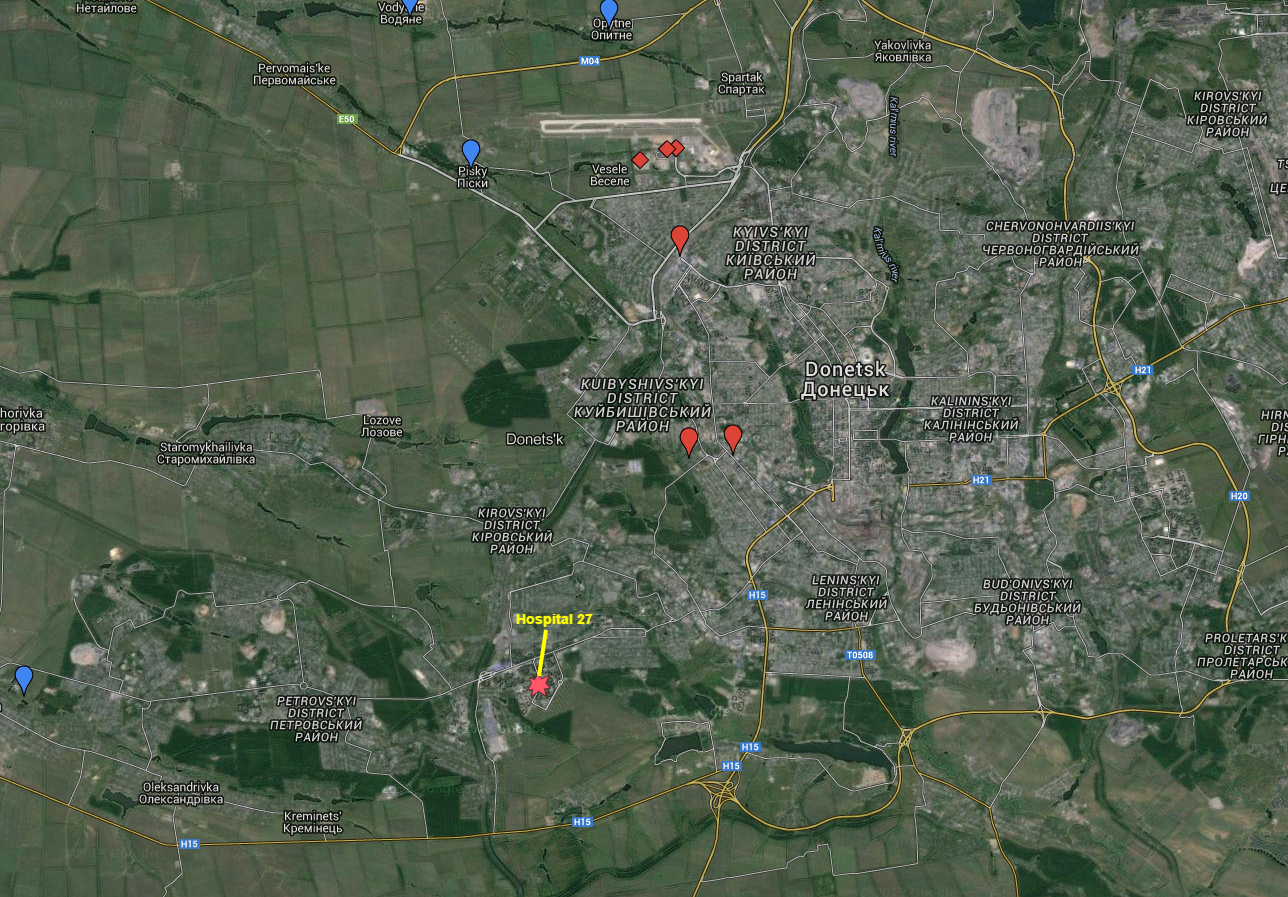
Translation: #Donetsk 3 people killed and many wounded after a shell fell on a hospital and apartment block in the Tekstilshchik area.
The BBC reported that at least four civilians had been killed.
City authorities said most of the casualties were outside the building.
There are unconfirmed reports of further deaths.
Journalists in Donetsk reported heavy shelling:
Translation: After a largely calm journey yesterday, the blasts have started up again this morning in Donetsk.
There have been no claims yet as to the origin of the shelling.
— Pierre Vaux